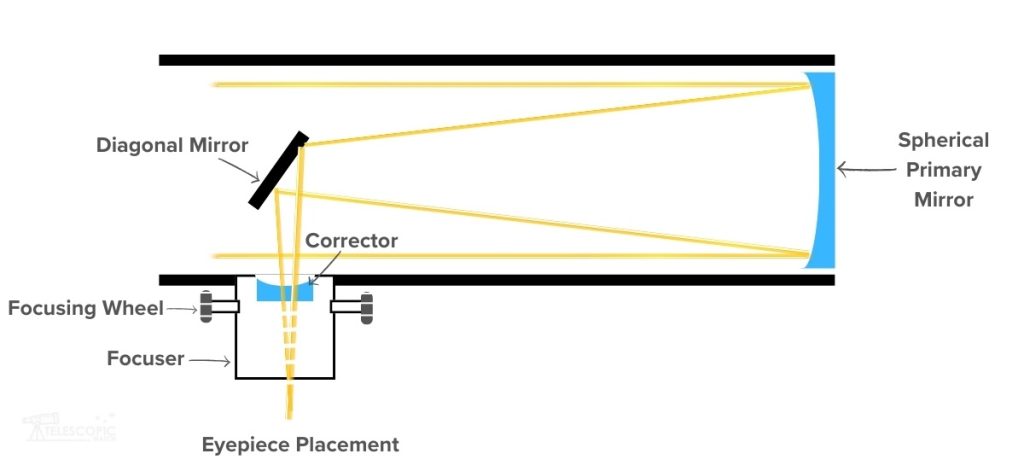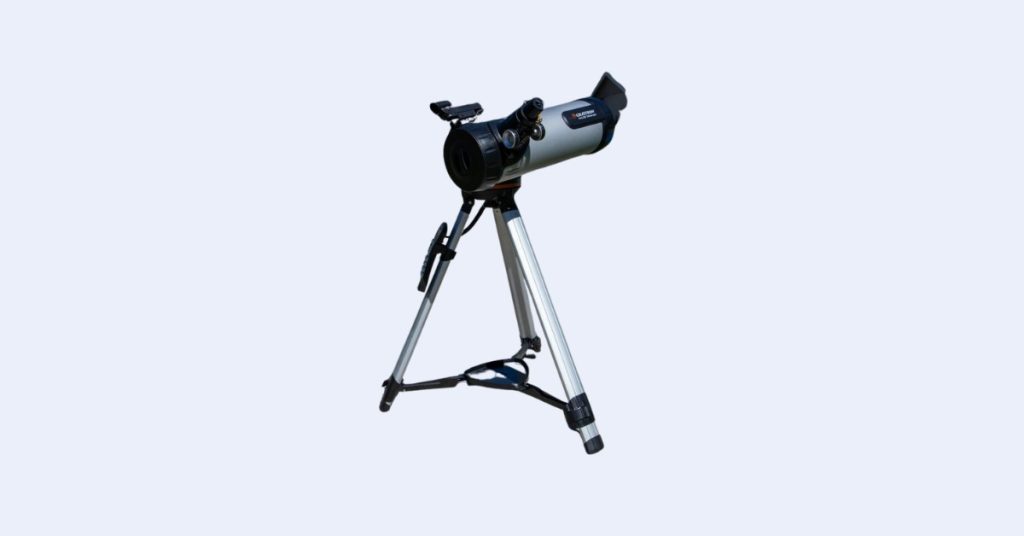The 114LCM Optical Tube Assembly Performance
The Celestron 114 LCM’s optical tube is the exact same as Celestron’s AstroMaster 114EQ telescope that I’ve already tested, making it a 114 mm f/8.77 Bird-Jones telescope, which is not a Newtonian reflector.
What’s Wrong With Bird-Jones?
I’ve talked enough about Bird-Joneses that you can simply read my review of the AstroMaster 114 here to get an idea of exactly how they “work”.

The simple version is that Bird Jones is a catadioptric Newtonian with a spherical primary mirror in place of the parabolic mirror that Newtonians typically use and a Barlow lens acting as a “corrector” to “fix” the spherical aberration caused by the spherical primary mirror. This design, in practice, doesn’t work at all.
The Bird Jones design causes further problems when we inevitably need to collimate the telescope.
Collimation in the 114LCM requires disassembly of the focuser and removal of the tiny “corrector” unit. The telescope then has to be carefully collimated with a laser collimator. As the scope is also only around f/3.5 when “corrector” is removed, down from the specified f/8.77, collimation requires high precision. Once the collimation is done, we also have to put everything back in place.
As I see it, all of this is obviously not the easiest thing for a beginner who’s never collimated anything before, let alone an experienced astronomer like myself.
Offers Mediocre Eyepieces
The Celestron 114 LCM computerised telescope comes with extremely cheap 25 mm (40x) and 9 mm (111x) Kellner eyepieces. Even though I’ve found that these eyepieces are sharper and have wider fields of view than the utterly destitute Huygens and Ramsden eyepieces that I’ve seen coming with Celestron’s cheapest telescopes, they still don’t meet modern standards of quality.
The 9 mm has too much magnification for the scope’s optics to handle, despite it being well within the magnification possible with a quality 4.5-inch telescope. The 114 LCM is, of course, not one of the quality 4.5-inch telescopes.
The 114LCM uses a 1.25” focuser, so it can at least take most standard eyepieces. However, you’ve got to keep in mind that even the best eyepieces available cannot compensate for the natively poor optics of the telescope itself.
Other Accessories or The Lack Of
Some pictures of the 114 LCM on Amazon and other shopping sites show that it comes with an Amici erecting prism diagonal. This accessory was not included with my purchase for some reason. Anyway, I know for certain that the Amici prism won’t work well with the 114 LCM. So I’ve got no complaints.
For aligning the mount’s GoTo system, the 114LCM comes with Celestron’s standard “StarPointer” red dot finder, essentially a glorified gun sight. But I believe it is plenty adequate for the job.
Reviewing the Lightweight Computerised Mount
As someone who has tried many inexpensive computerised mounts, in my view, Celestron’s Lightweight Computerised Mount (LCM) is laughably cheap. From what I’ve seen, the internal gearing is cheap and prone to stripping and inaccuracies. You can power it with a bunch of AA batteries, but it will quickly drain those, and as such, you really need some sort of auxiliary power supply or an AC power cord.
Even though it is made of cheap parts, the LCM swivels and tracks pretty well and works fine. However, it has two fatal flaws, if you ask me.
- The design of the LCM puts the telescope’s optical tube on the side of the center of the tripod at all times. This design decreases the stability of the scope and is unlike almost all good alt-azimuth mounts, where fork arms keep the tube centerd on the tripod. LCM’s offset design, when combined with the scope’s extremely light weight, makes the whole scope vulnerable to being toppled over by children, pets, or even just myself if not careful.
- To me, the LCM’s supplied tripod is an utter joke. The legs, which are little more than thin-walled, asymmetrical aluminium “tubes,” don’t have proper tips or feet. They rather have simple, flattened ends with some rubber slapped on them. The spreader, leg-retaining hardware, and the fasteners/clamps for keeping the legs extended/retracted are also all plastic.
As a result of all of this, the 114 LCM only weighs 13.2 pounds when assembled and, as far as I’m concerned, it has the stability of JELL-O. Even at low power, with the legs extended, the scope wobbles when the focus knob is turned. Forget trying high magnification, even if the scope’s optics could handle it.
Also, because it’s so easy to accidentally move it, it’s easy to ruin the GoTo alignment. Resetting it requires rebooting the scope and starting the alignment all over again.
I would like to say that the scope’s light weight is an attempt by Celestron to make it more convenient, but it’s not. It just makes the shipping cheaper and allows them to use less materials.
The LCM’s hand controller is Celestron’s standard NexStar+ hand controller. Unlike their more expensive telescopes, which have catalogues of over 40,000 objects, the LCM’s hand controller’s database contains only 4,000 objects. A 4.5-inch telescope will probably be lucky to show half of them anyway.
Alternative Recommendations
The Celestron 114LCM is nothing short of a rip-off at its shockingly high price, and you could get a number of superior alternatives that will beat the 114LCM in clarity, image brightness, and value for the money at a similar or even lower cost.
Under £325
- The Zhumell Z114 and Orion StarBlast 4.5 Astro have the same aperture as the 114LCM, but parabolic primary mirrors free of the shoddy Bird-Jones corrector lens design that the 114LCM uses. Their tabletop Dobsonian mounts are portable, quick to set up and easy to aim, and the included accessories are pretty good, too.
- The Sky-Watcher Heritage 130P of course has sharper optics than the 114LCM by far, as well as a significant boost in light gathering power, a compact collapsable tube design, well-made included accessories, and an easy-to-use tabletop Dobsonian mount.
- The Sky-Watcher Heritage 150P provides a huge 6” of aperture in an easy-to-use tabletop Dobsonian design with a collapsable tube just like the Heritage 130P. The views are miles ahead of the 114LCM or any smaller aperture instrument regardless of optical quality (or lack thereof).
£325-£425
- The Sky-Watcher Virtuoso GTi 150P adds on GoTo technology to the Heritage 150P, but can still be aimed manually with or without the electronics powered on, making it even more convenient to set up and use. A 130mm version (based on the Heritage 130P) is also available, but the difference in price and portability is so small we’d recommend you get the 150P GTi version.
- The Bresser Messier 6” f/8 Planetary Dobsonian offers, once again, a massive improvement in image quality and brightness compared to the Celestron 114LCM, and unlike the other scopes on this lits stands on its own free of a table or tripod thanks to its long tube and full-sized Dobsonian base. It sports a high-quality 2” single-speed Crayford focuser, too.
Aftermarket Accessory Recommendations
It could be argued to be a waste of money to upgrade the Celestron 114LCM with better eyepieces when the money spent could go towards simply purchasing a better and more functional instrument. However, additional eyepieces can be used with another telescope in the future and can slightly improve the observing experience with your 114LCM, despite its flawed optics. A 15mm “redline” or “goldline” eyepiece (67x) should still be able to provide sharp images and can reveal some planetary detail without pushing beyond what the telescope can realistically handle before the optics simply put up mushy and dim images. A 9mm redline or goldline eyepiece (111x) is higher-quality than the included 10mm eyepiece, but probably too much magnification for the 114LCM to realistically be expected to put up a sharp images due to the scope’s optical flaws.
What can you see with the Celestron 114 LCM?
The 114LCM’s low-quality optics and wobbly mount give it severe limitations when it comes to viewing anything, but particularly the Moon and planets. Jupiter’s moons can be seen, but only as fuzzy star-like points. Its cloud belts lack contrast, and the Great Red Spot is likely out of reach. Saturn’s rings are visible, but the Cassini Division within them will elude you, and you’ll likely have trouble spotting its cloud bands or any of its moons. Venus’s phases are easy to spot; Mercury’s small disk will likely be little more than a smear with the 114LCM. Mars will likely be a fuzzy orange ball. The Moon looks nice through the 114LCM, but that’s not exactly a tough barrier for most telescopes.
Assuming you can keep the scope steady enough to get it pointed at deep-sky objects, they won’t be so bad, though the long focal ratio of the 114LCM means the field of view is somewhat cramped compared to other telescopes of its aperture. You’ll have no trouble seeing the Orion Nebula, the Ring, the dust lanes in M82, and many of the other popular deep-sky objects as they would appear in any other 4.5” telescope—that is, mostly dim smudges devoid of detail. However, attempting to spot fine details in the Orion Nebula or begin to resolve globular clusters is futile, as cranking up the magnification with the 114LCM’s poor optics will result in a blurry, out-of-focus image no matter what you do. Additionally, the contrast of the views compared to most telescopes of the same aperture is likely to be poor due to the low quality of the built-in corrector lens of the Celestron 114LCM computerised telescope.


